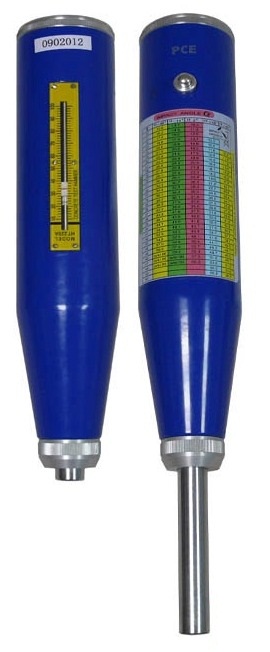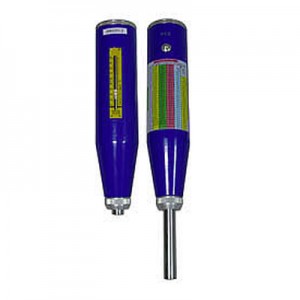|
Range of measurement |
100 to 600 kg/cm² (~9.81 to 58.9 N/mm²) |
|
Accuracy |
±18 kg/cm² (~±1.8 N/mm²) |
|
Energy |
2207 J |
|
Indication of measurement |
0 to 100 (without dimensions) |
|
Scale for the resistance to pressure at the back |
to convert values indicated without dimensions to kg/cm² (with introduction of angle) |
|
Correction table for measurements |
in the user's manual |
|
Maximum thickness of concrete (of the material) |
70cm |
|
Dimensions |
diameter de 66 x 280mm |
|
Weight |
1kg |
Manufacturer: PCE UK
Warranty: 12 months
|
Handheld mechanical durometer for testing concrete |
|
|
The PCE-HT-225A durometer for concrete is easy to use and is fundamentally used in the construction industry as well as other industrial sectors (testing for Wickel hardness of rolls in commodities). This durometer in the form of a hammer device for testing concrete is based on the Schmidt principal of measurement. Testing is always done under the same test energy of 2207 J. The kinetic energy of the rebound is givne by the device as the measurement of the hardness of concrete, of the pressure upon the surface or as the resistance to pressure (kg/cm² or its conversion to N/mm²). The quality of concrete is useful in understanding the material's resistance to pressure, as an orientating value for testing the load capacity and durability of concrete constructions. Resisitance to pressure is represented as a series of numbers and letters, for example: B 25 indicates that the material is normal concrete with a resistance to a pressure equal to 25 N/mm². Different readings exsist up to the highest class of resistance which is indicated as B 55. With our durometer you will be able to easily and accurately classify concrete. The durometer comes calibrated from the manufacturer but an ISO calibration certificate can be ordered seperately at extra cost. |
|
|
- Solid design.
|
 PCE-HT-225A durometer for concrete View or print the user's manual  |
|
General information about concrete's resistance to pressure |
|
|
Resistance to pressure is generally defined as the measurement of resistance to breaking under a particular pressure load at an axis during a brief point in time. The resistance to pressure of concrete is determined, taking into account the following parameters: |
|
|
The image to the right shows the durometer measuring a plinth of an old wall in an old factory building. The plinth is not inlcuded and for this reason, the measurement is made on the painted concrete surface. The degree of hardness is obtained accurately after the measurement is done using the rebound body (rebound value = R) upon the surface of the concrete and with the help of a conversion table on the back or in the user's manual. |
|
|
Technical specifications |
|
|
Range of measurement |
100 to 600 kg/cm² (~9.81 to 58.9 N/mm²) |
|
Accuracy |
±18 kg/cm² (~±1.8 N/mm²) |
|
Energy |
2207 J |
|
Indication of measurement |
0 to 100 (without dimensions) |
|
Scale for the resistance to pressure at the back |
to convert values indicated without dimensions to kg/cm² (with introduction of angle) |
|
Correction table for measurements |
in the user's manual |
|
Maximum thickness of concrete (of the material) |
70cm |
|
Dimensions |
diameter de 66 x 280mm |
|
Weight |
1kg |
|
Contents |
|
SIÊU THỊ THIẾT BỊ ĐO QUANG MINH - CÔNG TY TNHH ĐẦU TƯ VÀ TT QUANG MINH
ĐT: 04.3873.0880 - Hotline: 090.400.3848 - Fax: 04.3873.0880
Email: kd@sieuthithietbido.com - Website: www.sieuthithietbido.com - www.sieuthithietbidienmay.net
 By Siêu thị thiết bị đo Quang Minh
Siêu thị thiết bị điện máy Quang Minh: nhà cung cấp Thiết bị đo độ cứng bề mặt bê tông PCE HT-225A Chính hãng Giá rẻ nhất - Gọi ngay 04.3873.0880 - 090.400.3848
5 sao trên
2494 khách hàng bình chọn
By Siêu thị thiết bị đo Quang Minh
Siêu thị thiết bị điện máy Quang Minh: nhà cung cấp Thiết bị đo độ cứng bề mặt bê tông PCE HT-225A Chính hãng Giá rẻ nhất - Gọi ngay 04.3873.0880 - 090.400.3848
5 sao trên
2494 khách hàng bình chọn